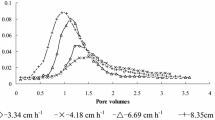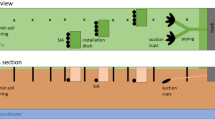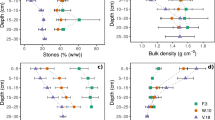Abstract
Fresh water scarcity is an increasing problem worldwide. Strategies to alleviate water scarcity include the use of low-quality water for irrigation. The risk of groundwater contamination by pollutants in this water is affected by soil heterogeneity and preferential flow. These risk factors can be assessed by measuring the spatio-temporal redistribution of uniformly applied water and solutes. We placed a soil monolith (height 29 cm) from an Australian vineyard on a 100-cell multi-compartment sampler (MCS). At this vineyard, treated wastewater is used in response to the severe shortage of water in the summer. We studied the leaching risk associated with heterogeneous or preferential flow by irrigating the soil column with 24 applications to simulate one year. We applied simulated rainfall as well as wastewater (which contained chloride) during summer while relying on rainfall only in winter. We compared the chloride leaching with the leaching of bromide, which was applied during one of the applications as a pulse. During the entire simulated year, leaching of solutes from the monolith was measured. The results indicate that the assumption of uniform flow would underestimate the risk for the fresh groundwater reserves: 25 % of the solutes are transported though 6 % of the soil’s cross-section. The spatial distribution of drainage and solute leaching varied little during the experiment. Consequently, the mass flux density pattern of the bromide pulse was comparable to that of the repeatedly applied chloride. However, the MCS data suggested lateral ‘escape’ from chloride to non-mobile areas, which means in the long run, considerable quantities of these solutes can build up in areas that do not receive irrigation water.








Similar content being viewed by others
References
APHA (1999) Standard methods for the examination of water and wastewater, 20th edn. American Public Health Association, American Water Works Association, and Water Environment Federation, Washington DC
Badawy NS (1982) Soils of the vineyards of the Great Western district. Research Project Series No 133. Division of Agricultural Chemistry, Department of Agriculture, Victoria
Bennett AJ (2000) Environmental consequences of increasing production: some current perspectives. Agr Ecosyst Environ 82:89–95
Binnie C, Kimber M, Smethurst G (2002) Basic water treatment, 3rd Edition. Thomas Telford Publishing
Bloem E (2008) Variation in space and time of water flow and solute transport in heterogeneous soils and aquifers—a new multi-compartment percolation sampler and a new parameterization of the spatio-temporal solute distribution. Ph.D. thesis, Wageningen University, The Netherlands, xii+153 pp. ISBN 978-90-8504-922-7
Bloem E, Hogervorst FAN, de Rooij GH (2009) A field experiment with variable-suction multi-compartment samplers to measure the spatio-temporal distribution of solute leaching in an agricultural soil. J Contam Hydrol 105:131–145. doi:10.1016/j.jconhyd.2008.11.010
Bloem E, Hogervorst FAN, de Rooij GH, Stagnitti F (2010) Variable-suction multicompartment samplers to measure spatiotemporal unsaturated water and solute fluxes. Vadose Zone J 9:148–159. doi:10.2136/vzj2008.0111
Buchter B, Hinz C, Flury M, Flühler H (1995) Heterogeneous flow and solute transport in an unsaturated stony soil monolith. Soil Sci Soc Am J 59(1):14–21
Candela L, Fabregat S, Josa A, Suriol J, Vigués N, Mas J (2007) Assessment of soil and groundwater impacts by treated urban wastewater reuse. A case study: Application in a golf course (Girona, Spain). Sci Total Environ 374:26–35
Coleman DC, Crossley DA (1996) Fundamentals of soil ecology. Academic Press, London
de Rooij GH (1996) Preferential flow in water-repellent sandy soils—model development and lysimeter experiments. Doctoral Thesis, Wageningen Agricultural University, The Netherlands, p 229
de Rooij GH, Stagnitti F (2000) Spatial variability of solute leaching: experimental validation of a quantitative parameterization. Soil Sci Soc Am J 64(2):499–504
de Rooij GH, Stagnitti F (2002a) The solute leaching surface as a tool to assess the performance of multidimensional unsaturated solute transport models. In: Hassanizadeh SM, Schotting RJ, Gray WG, Pinder GF (eds) Pre-conference proceedings of the International Conference on Computational Methods in Water Resources. Delft, The Netherlands. Elsevier, Amsterdam, The Netherlands, pp. 639–646
de Rooij GH, Stagnitti F (2002b) Spatial and temporal distribution of solute leaching in heterogeneous soils: analysis and application to multisampler lysimeter data. J Contam Hydrol 54:329–346
de Rooij GH, Stagnitti F (2004) Applications of the beta distribution in soil science. In: Gupta AK, Nadarajah S (eds) Handbook of Beta distribution and its applications. Marcel Dekker, Inc., New York, pp 535–550
EPA (2000) A guide to the sampling and analysis of waters, wastewaters, soils and wastes, 7th edn. Environment Protection Authority, Victoria, Publication 441
Epstein L, Bassein S (2001) Pesticide applications of copper on perenial crops in California, 1993 to 1998. J Environ Qual 30:1844–1847
Flemming CA, Trevors JT (1989) Copper toxicity and chemistry in the environment: a review. Water Air and Soil Pollut 44:143–158
Flühler H, Durner W, Flury M (1996) Lateral solute mixing processes—a key for understanding field-scale solute transport of water and solutes. Geoderma 70:165–183
Hespanhol I (1997) Wastewater as a resource. In: Helmer, R., Hespanhol, I. (Eds.), Water pollution control—A guide to the use of water quality management principles. Published by E. and F. N. Spon, London on behalf of WHO/UNEP, pp. 91–124
Isbell RF, McDonald WS, Ashton LJ (1997) Concepts and rationale of the Australian soil classification. CSIRO, Australia
Khan AUH, Jury WA (1990) A laboratory study of the dispersion scale effect in column outflow experiments. J Contam Hydrol 5:119–131
Maher PM, Hermon KM, Allinson G, Stagnitti F, Armstrong R (2005) Variability of soil chemistry following irrigation with municipal effluent: a Great Western vineyard study. Water Resour Manag III, WIT Trans Ecol Environ 80:655–675, ISBN: 1-84564-007-1
Nannipieri P, Badalucco L (2003) Biological processes. In: Bembi D, Nieder R (eds) Processes in the soil-plant system: modelling concepts and applications. The Haworth Press, Binghamton, NY
Pimentel D, Bailey O, Kim P, Mullaney E, Calabrese J, Walman L, Nelson F, Yao X (1999) Will limits of the earth’s resources control human numbers? Environ Dev Sustain 1:19–39
Poletika NN, Jury WA (1994) Effects of soil surface management on water flow distribution and solute dispersion. Soil Sci Soc Am J 58(4):999–1006
Qadir M, Boers TM, Schubert S, Ghafoor A, Murtaza G (2003) Agricultural water management in water-starved countries: challanges and opportunities. Agr Water Manag 62:165–185
Quisenberry VL, Phillips RE, Zeleznik JM (1994) Spatial distribution of water and chloride macropore flow in a well-structured soil. Soil Sci Soc Am J 58(5):1294–1300
Stagnitti F, Li L, Allinson G, Phillips I, Lockington D, Zeiliguer A, Allinson M, Lloyd-Smith J, Xie M (1999) A mathematical model for estimating the extent of solute- and water-flux heterogeneity in multiple sample percolation experiments. J Hydrol 215:59–69
Stagnitti F, Sherwood J, Allinson G, Evans L, Allinson M, Li L, Phillips I (1998) An investigation of localised soil heterogeneities on solute transport using a multisegment percolation system. New Zeal J Agr Res 41:603–612
Stevens D (2006) Growing crops with reclaimed wastewater. CSIRO Publishing, Melbourne
Strock JS, Cassel DK, Gumpertz ML (2001) Spatial variability of water and bromide transport through variably saturated soil blocks. Soil Sci Soc Am J 65(6):1607–1617
USEPA (1993) The determination of inorganic anions in water by ion chromatography. U.S. Environment Protection Agency Method 300.0, Cincinnati, Ohio,
Wildenschild D, Jensen KH, Villholth K, Illangasekare TH (1994) A laboratory analysis of the effect of macropores on solute transport. Ground Water 32(3):381–389
Acknowledgement
This research was supported by the Research Council for Earth and Life Sciences (ALW) with financial aid from the Netherlands Organization for Scientific Research (NWO). We thank the anonymous reviewers for their constructive comments that helped improve the manuscript.
Author information
Authors and Affiliations
Corresponding author
Additional information
Responsible editor: Zhihong Xu
Rights and permissions
About this article
Cite this article
Bloem, E., Hermon, K.M., de Rooij, G.H. et al. Spatial and temporal distribution of the leaching of surface applied tracers from an irrigated monolith of a loamy vineyard soil. Environ Sci Pollut Res 21, 8981–8991 (2014). https://doi.org/10.1007/s11356-014-2637-x
Received:
Accepted:
Published:
Issue Date:
DOI: https://doi.org/10.1007/s11356-014-2637-x




